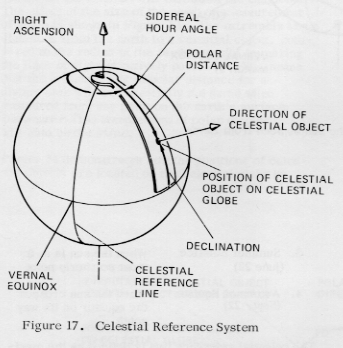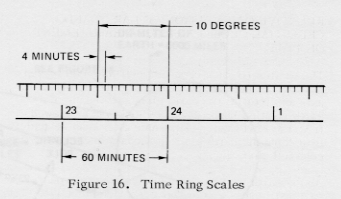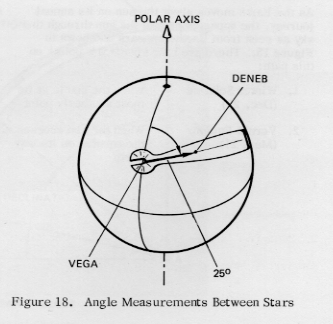|
In specifying right ascension and sidereal hour angle, angle measurements are based on the division of the circle into 24 equal parts, each of which contains 15 degrees. Each 15° segment represents an hour and is further divided into 60 minutes. Thus, there are 60/15 = 4 minutes per degree. The Uniglobe time ring has two scales. See Figure 16. The upper shows degrees. The lower scale is divided into 24 segments, each of which includes 15 degrees. When the time ring is set with the 24 mark on the vernal equinox, a direct reading of right ascension of any star may be made by placing the spanner cursor over the star and reading the number of hours and minutes along the time ring from the vernal equinox to the intersection of the time ring with the spanner cursor. The path of the sun as seen from the earth is called the ECLIPTIC. The ecliptic forms an angle of approximately 23 1/2° with the equator.  As in the case of the Earth Globe, angle measurements may be made with the spanner between points on the celestial globe. Since these points are not at the same distance from the earth, the spanner cannot represent linear distance between objects in the sky. Figure 18 shows the angle measurement between Vega and Deneb as 25°. |
 EXERCISES 1. Set the time ring 24 hour mark on the Vernal Equinox. Measure the right ascension of RIGEL. Confirm that it is approximately 5 hours and 12 minutes. 2. Plot the position of an object on the ecliptic at right ascension of 6 hours. (Position of summer solstice). The reference system used on the celestial globe is shown in Figure 17. The term DECLINATION is used to denote the angle which was called LATITUDE on the earth globe. All other terms are analogous. For example: the declination of Vega is 37° N, and the right ascension is approximately 280° or 18 hours 35 minutes. EXERCISE 1. Plot a star on the celestial globe whose position is 6 h 43 m right ascension and 16 1/2° S. This star is the brightest star in the sky, Sirius.  |